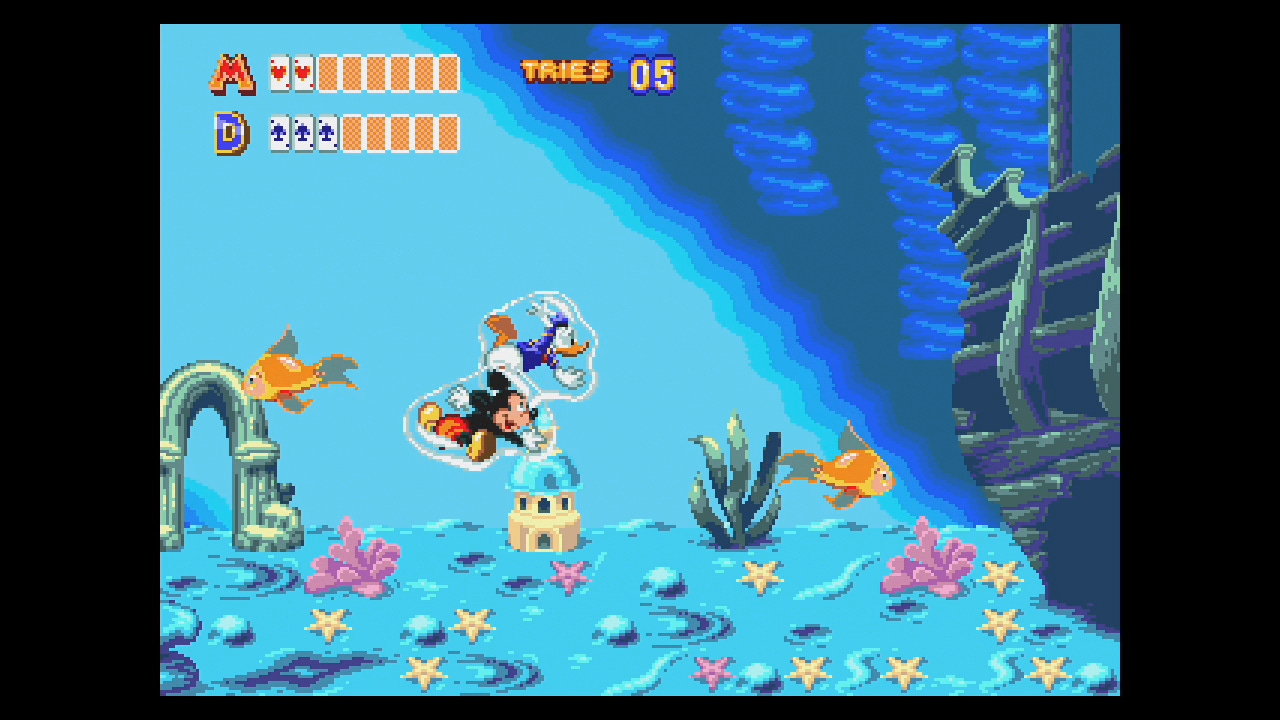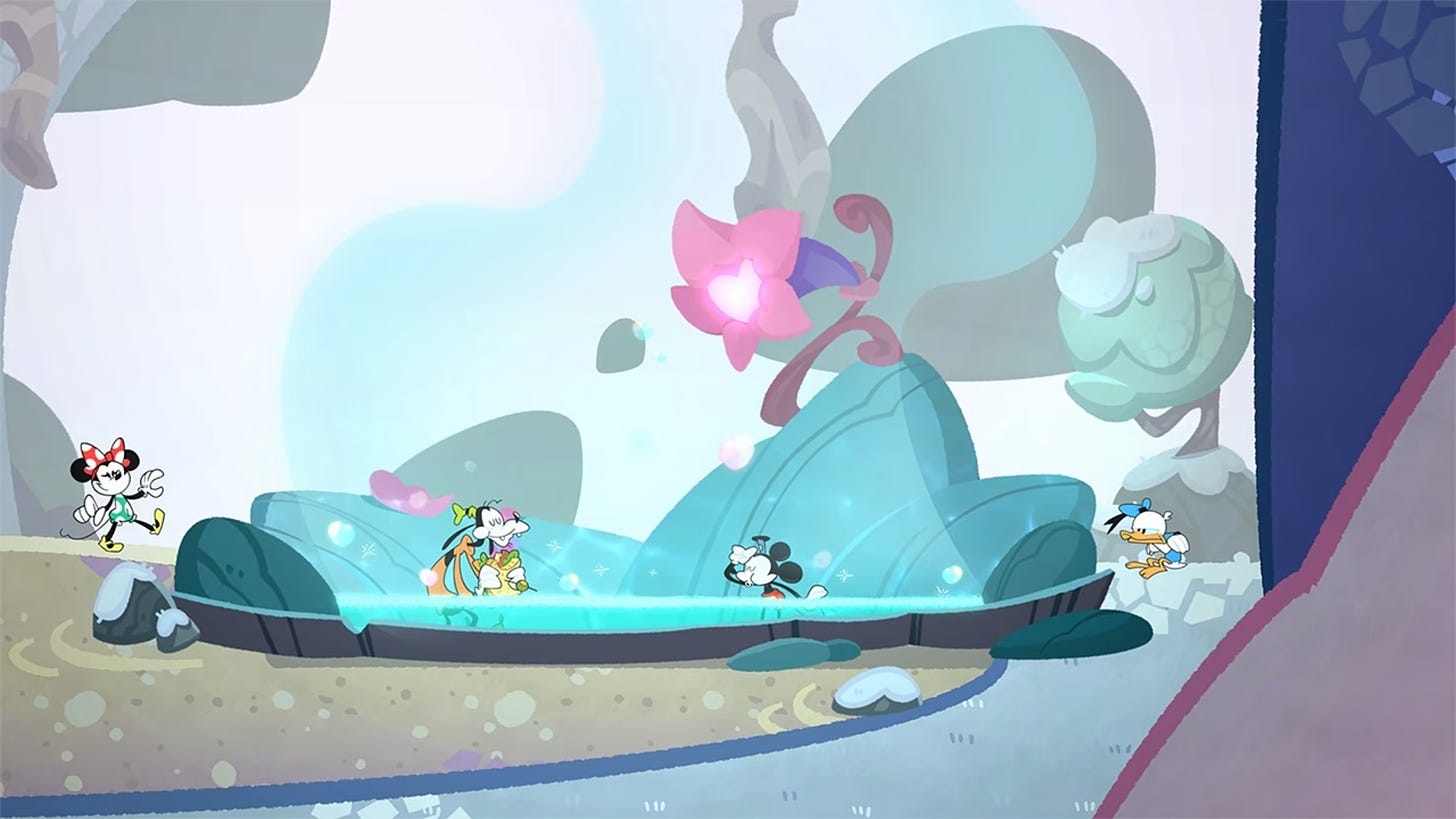The Creators of Disney’s New Platformer Explain the Hard Lessons of Making Games for Kids
Too often, the developers of Disney Illusion Island would be “making game design solutions for game designers, not for players” and having to start over.
It’s easy to spend a few minutes with Disney Illusion Island, an upcoming platformer currently exclusive to the Switch, and conclude it’s a game meant for everyone—adults, kids, everything in-between. And while it’s true the game’s developer hopes the game can attract a wide audience, it’s not actually meant to be a game for everyone.
“Everyone always says, ‘oh, you know, my game is for everyone,” said creative director AJ Grand-Scrutton, who’s also CEO of the game’s developer, Dlala, to Crossplay in a recent interview. “But no one really can make a game for everyone, right? Because I think if you try to make something that everyone will love, no one loves it. So for us, what was important is that we made something that was welcoming.”
He used that word several times in our conversation: “welcoming.”
Grand-Scrutton and I were speaking on a remarkably comfortable couch at last week’s Summer Games Fest event in Los Angeles, a gathering for games media and other professionals to play unreleased games, talk with game developers, and socialize. An early version of the game was running on TVs nearby, and my 30 minutes with Disney Illusion Island had me wondering what exactly it means to make a video game for families and, specifically, for children. That’s not “everyone.” It's a specific group.
“We [the developers] are those platform fans from the 90s, we loved World of Illusion,” said Grand-Scrutton, referencing 1992’s classic Disney platformer for the Sega Genesis. “But we've got kids, we've got nieces and nephews, we want to make stuff that we can play with them. It's such a cliched thing to say that once you and your friends start having kids, your world changes, but it does.”
Though Grand-Scrutton doesn’t have kids yet, his personal life includes friends and families who’ve been having kids over the past decade, and he’s especially close with a seven-year-old niece who’s been playing the game while it’s been in development.

While playing Disney Illusion Island, I noticed a mechanic that allowed players to drop a rope for other players to climb. The rope isn’t on a cooldown, nor a set length. If one player makes it through a platforming sequence that ends up with them higher than the others, they can drop a rope with the touch of a button and everyone can climb.
The rope didn’t always function this way, Grand-Scrutton told me. At first, the rope would only drop a certain length, because, the thinking went, they didn’t want people to be skipping parts of levels. Players would be rob of a sense of accomplishment.
But over time, the arbitrary limitations gave the team pause.
“What is the benefit of not letting that rope go to full length for the screen?” said Grand-Scrutton. “Oh, it means people can skip all the content. Well, one person has to have got through it all, and the only people skipping it are the people that probably are struggling.”
Over and over, he noted, the team would introduce a “welcoming” idea, yet adhere it to more traditional platforming standards, essentially “making game design solutions for game designers, not for players.” It was a lot of hand wringing over “the integrity of design,” when the team constantly found itself drawn to ensuring players have fun.
“We have this phrase internally, we say ‘don't make a rosé,” said Grand-Scrutton. “And it's because one of my friends in the industry, one of my mentors, he had this phrase to me, and he said that if you go to a restaurant and you've got someone that loves red wine, or someone loves white wine, you don't give them a rose because no one's happy. You gave them an awesome red or an awesome white. So we say that internally, when we are riding this line of only half doing something, we say ‘it's too rosé.’ Rosé is a perfectly fine wine choice, but we felt we were rosé-ing it.”
During development, the team has engaged in regular focus tests with different age groups, including families. Grand-Scrutton said the family focus tests often involved two parents, a “teen or tween” kid and a much younger child. These groups covered a huge age spectrum, and it revealed the ways differently aged people bring alternative forms of baggage to playing games.
Take, for example, the game’s bouncy pads. This is standard stuff in platformers, where players get a little extra boost by hopping on them. What Grand-Scrutton noticed, however, was that younger players would press jump, hit the bouncy pad and move on, while older players would press jump, try to press jump again as they hit the bouncy pad, and end up cancelling the bounce entirely.
Let’s rewind, because this goes all the way back to the original Mario games:
The Mario note blocks are a particularly infamous example of this design in action. To gain extra height, players must time hitting the jump button to hitting the music note. It’s always frustrated me! (It’s also a visual sign that, when playing New Super Mario Bros. with my kid, she’s going to sit out that level. She hates the note blocks.) But this is the baggage that Grand-Scrutton is talking about: older players assuming this rule applies everywhere else. But when they tried pulling it off in Disney Island Illusion, a game where it doesn’t exist, the jump would cancel, and players would get confused.
“No one knows this until you actually get told it,” he explained. “If you try and press the double jump button a certain height above the bounce block, we ignore it. We say we're not going to let you do this so that you can't muck up your bounce.”
There are many tiny details the team has been paying attention to, such as the way younger players can struggle to differentiate between the art that’s in the foreground and the art in the background. Frequently, the team found, those players were trying to jump through a wall because, to them, it wasn’t clear it was a wall at all!
Or how players can seamlessly adjust the difficulty between one, two, three, or infinite “hits” before the character poofs away, and the game doesn’t judge them for it. Or how any player left behind will automatically be dropped off with the rest of the players only moments later. Or how they ended up with a hugging mechanic.
“Everyone always says, ‘oh, you know, my game is for everyone. But no one really can make a game for everyone, right? Because I think if you try to make something that everyone will love, no one loves it. So for us, what was important is that we made something that was welcoming.”
In Disney Illusion Island, players can hug another character and grant each other an extra heart that disappears when they “die.” (Calling it “death” isn’t really fair, because this isn’t a game where there’s all that much punishment for losing, and I don’t think Mikey and co. are, uh, actually dying.) But hugging was lacking something important!
“This is no word of a lie,” said Grand-Scrutton, laughing. “The animations were done. The feature was done. You can hug—and it didn't do anything. We didn't know what it was going to do, we just knew we wanted hugging.”
Then, someone on the team wondered if the reward for players hugging could be an extra heart for 20 seconds, a way for players to get a temporary boost. But much like the rope, this ultimately was an idea running away from “welcoming.” Now, hugging grants players an extra heart, albeit one that can disappear, without any restrictions.
“We went through the same thing,” said Grand-Scrutton. “We're rose-ing it again.”
Disney Illusion Island releases on July 28 for Switch.
Also:
I worry Disney Illusion Island is struggling with its identity. In playing it, the game struck me as still too tough for young kids, yet too simple for older ones.
It’s great that Disney is making, or letting others make, games again. Their film output is mixed lately, but I’m anxious to see Disney fans play in their worlds.
If you’re a game developer who makes games for kids, or kids in mind, get in touch. I’d love to talk with more developers about these approaches to design.






I'm loving the AV Club style bullets at the end of these.
Congrats on the feature Patrick! Very well deserved.